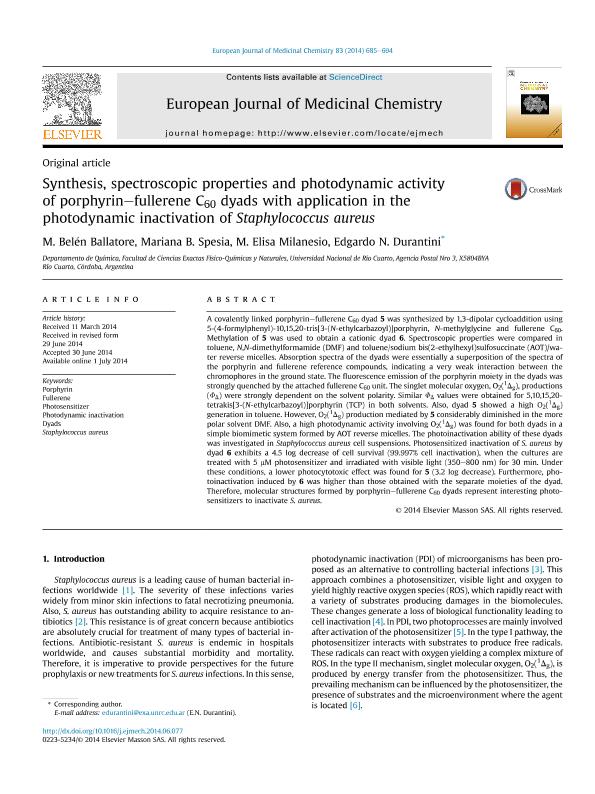Artículo
Synthesis, spectroscopic properties and photodynamic activity of porphyrin–fullerene C60 dyads with application in the photodynamic inactivation of Staphylococcus aureus
Fecha de publicación:
07/2014
Editorial:
Elsevier Masson
Revista:
European Journal of Medical Chemistry
ISSN:
0223-5234
Idioma:
Inglés
Tipo de recurso:
Artículo publicado
Clasificación temática:
Resumen
A covalently linked porphyrin–fullerene C60 dyad 5 was synthesized by 1,3-dipolar cycloaddition using 5-(4-formylphenyl)-10,15,20-tris[3-(N-ethylcarbazoyl)]porphyrin, N-methylglycine and fullerene C60. Methylation of 5 was used to obtain a cationic dyad 6. Spectroscopic properties were compared in toluene, N,N-dimethylformamide (DMF) and toluene/sodium bis(2-ethylhexyl)sulfosuccinate (AOT)/water reverse micelles. Absorption spectra of the dyads were essentially a superposition of the spectra of the porphyrin and fullerene reference compounds, indicating a very weak interaction between the chromophores in the ground state. The fluorescence emission of the porphyrin moiety in the dyads was strongly quenched by the attached fullerene C60 unit. The singlet molecular oxygen, O2(1Δg), productions (ΦΔ) were strongly dependent on the solvent polarity. Similar ΦΔ values were obtained for 5,10,15,20-tetrakis[3-(N-ethylcarbazoyl)]porphyrin (TCP) in both solvents. Also, dyad 5 showed a high O2(1Δg) generation in toluene. However, O2(1Δg) production mediated by 5 considerably diminished in the more polar solvent DMF. Also, a high photodynamic activity involving O2(1Δg) was found for both dyads in a simple biomimetic system formed by AOT reverse micelles. The photoinactivation ability of these dyads was investigated in Staphylococcus aureus cell suspensions. Photosensitized inactivation of S. aureus by dyad 6 exhibits a 4.5 log decrease of cell survival (99.997% cell inactivation), when the cultures are treated with 5 μM photosensitizer and irradiated with visible light (350–800 nm) for 30 min. Under these conditions, a lower photocytotoxic effect was found for 5 (3.2 log decrease). Furthermore, photoinactivation induced by 6 was higher than those obtained with the separate moieties of the dyad. Therefore, molecular structures formed by porphyrin–fullerene C60 dyads represent interesting photosensitizers to inactivate S. aureus.
Palabras clave:
Dyad
,
Photodynamic Properties
Archivos asociados
Licencia
Identificadores
Colecciones
Articulos(CCT - CORDOBA)
Articulos de CTRO.CIENTIFICO TECNOL.CONICET - CORDOBA
Articulos de CTRO.CIENTIFICO TECNOL.CONICET - CORDOBA
Citación
Ballatore, María Belén; Spesia, Mariana Belen; Milanesio, María Elisa; Durantini, Edgardo Néstor; Synthesis, spectroscopic properties and photodynamic activity of porphyrin–fullerene C60 dyads with application in the photodynamic inactivation of Staphylococcus aureus; Elsevier Masson; European Journal of Medical Chemistry; 83; 7-2014; 685-694
Compartir
Altmétricas




